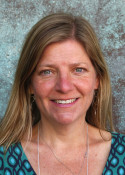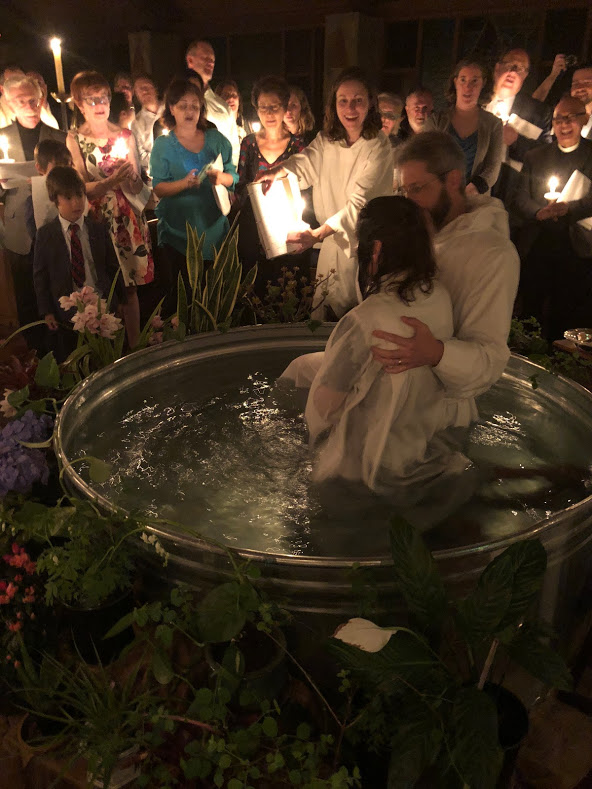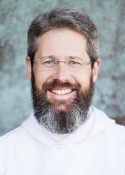FROM THE RECTOR
Open Source Jesus
Now that was a week. A Holy Week, I mean. I realize that it was several weeks ago, but in conversation with several All Soulsians in the past couple of days, apparently I am not alone in still feeling the reverberations of those intense, dramatic days. And as I’ve been sifting through the memories of the stories of remarkable vulnerability, the harmonies and deep silences, and the actions of heart-filled devotion, I am amazed and grateful at the many Christian communities that have given so that it can be so.
Because what we participate in during the Three Great Days, in structure, form, and content, is a feast centuries in the preparation. You may have heard me say that the very practice of Holy Week itself was brought to the wider world thanks to the travel diary of a 4th century Spanish nun named Egeria. And ever since, Christian communities have been borrowing from one another to access the heights and depths of these days.
Our music is an easy place to find this. The hymns, chants, anthems, and songs that we sang over the Triduum came from several continents and were written from the 2nd century through to the 21st. The hope is that even though they differ in style, that they amplify the given liturgical moment and help to draw us deeper into that part of the narrative of the day. Thanks to the leadership of our musicians, Jamie Apgar, and before Jamie, Christopher Putnam, we often have just the right piece, whether sourced from a Middle Ages motet or a Tanzanian song of praise.
It is especially in our Easter Vigil that the influences of other congregation’s practices can be seen. It begins at the start, with the Paschal Candle. A couple of decades ago, I was stunned to hear the folks at St. Timothy’s, Danville, CA talk about their practice of melting down the stubs of their beeswax candles to make a new Paschal Candle. Thanks to the skill and artistry of Jocelyn Bergen, every year we begin the new fire with a new creation.
One of the newest additions came to us from St. John’s, Portsmouth, VA. One of our Assisting Priests, the Rev. Dr. Ruth Meyers, also happens to have led the Standing Commission on Liturgy for the Episcopal Church and came across an Episcopal congregation that set up a full immersion baptismal font for the Easter Vigil. When our three adults were ready for the adventure (and Concord Feed had a stock pond that barely fit into the back of my truck), our baptismal pool was ready for use. And the resulting ritual is something that few of us will ever forget.
About 13 or 14 years ago, by happenchance Christopher Putnam and I ended up at the same Easter Vigil at St. Gregory’s, San Francisco, CA. There we both found an amazing element of their Vigil—a hinge between the readings of the Arc of Salvation and the first Eucharist of Easter. It involved a procession around the outside of their church singing a Litany of the Saints, inviting, imploring the saints of all times and ages to, “Come Rejoice With Us!” And now, every year, we invite them as well.
Lastly, the most recent addition to our Vigil came in the form of bubbles. About 12 years ago, when the Rev. Bonnie Perry, Rector of All Saints, Chicago, IL, was part of the Bishop’s Search process in this diocese, she talked about celebrating the first Eucharist of Easter with sparkling wine for Communion. If the Body is to be common food, and if the Blood is to be festive drink, then what better festive drink than Champagne? It was finally part of our celebration this year, and I have to say that it was just and meet and right to hear the popping of the bubbly cork as the final note of “At the Lamb’s high feast we sing…”
And so it is. Every time we come to those great days, we gather practices from Christian communities far and wide, grateful for those who freely offer what they have learned. And, my hope is that we, in turn, can serve as a witness for others of these glimpses of the Deep Mystery that surrounds us, offering ways large and small so that others can see it as well.
Peace,
Phil+
Solidarity with Fernando
 In last week’s sermon we listened to Liz talk about the faith and the divinity that shows up in our bodies, and how God is present in the real tangible aspects of our lives. Right now we see that divinity being rejected by a government that draws a border through Black and Brown bodies and denies them a place in our common life. As the Body of Christ we are called to stand not just in theoretical solidarity with our brothers and sisters but also in bodily solidarity and witness.
In last week’s sermon we listened to Liz talk about the faith and the divinity that shows up in our bodies, and how God is present in the real tangible aspects of our lives. Right now we see that divinity being rejected by a government that draws a border through Black and Brown bodies and denies them a place in our common life. As the Body of Christ we are called to stand not just in theoretical solidarity with our brothers and sisters but also in bodily solidarity and witness.
As you know, our Parish House guest Erik was recently arrested when he attended his court date. A local immigrant father, Fernando Carrillo, was detained with Erik at the West Country Detention Center previously, and was also recently released. The government is seeking to challenge his release, just as they did with Erik. Interfaith Movement for Human Integrity, the organization that supports our Parish House Accompaniment Team, has also been supporting Fernando and his family every step of the way. As we saw in the initial release of both these men, community support really does make a difference.
In these two men’s cases we can see the way recent changes in law and in the political climate are impacting individuals and their families. In solidarity with Fernando and his family, join members of the Justice and Peace Committee and Interfaith Movement for Human Integrity to accompany him to his ICE check in on Tuesday May 1st at 2:30 pm at 630 Sansome St. in San Francisco.
We will meet in the All Souls parking lot at 1:30 and take BART together.
Peace,
Christine Trost and Dani Gabriel
HOLY REFLECTIONS FROM A HOLY WEEK
 On Good Friday afternoon, seven wise and brave souls shared how their own stories connected with the characters of the cross. Today and in coming weeks, we will be offering some of those reflections, in no particular order, but with much gratitude.
On Good Friday afternoon, seven wise and brave souls shared how their own stories connected with the characters of the cross. Today and in coming weeks, we will be offering some of those reflections, in no particular order, but with much gratitude.
The Soldiers
Then Pilate took Jesus and had him flogged. And the soldiers wove a crown of thorns and put it on his head, and they dressed him in a purple robe. They kept coming up to him, saying, ‘Hail, King of the Jews!’ and striking him on the face. – John 19:1–3
Eleven years ago to the month, my husband, our young daughter, and I were sitting in a dumpling house in Beijing, having the feast of our lives. I was savoring a mixed mushroom variety when an intense pressure shot up my spine and gripped my head. My heart rhythm snapped into a thunder across my chest. I became terribly dizzy, and as I lay down on the chair next to me, images of my life scrolled across my mind like a movie reel. At some point, I lost consciousness.
I woke in an emergency room to a body that wasn’t my own. Everything was moving as though I was peering through a slow-moving kaleidoscope. My limbs felt numb and tingly. And I had a fatigue so deep I worried I couldn’t draw my next breath.
This marked the beginning of the rest of my life—an abrupt onset of chronic, complex conditions like dysautonomia, fibromyalgia, and chronic fatigue syndrome. I was bed-bound for the next six months, housebound for the next two years. The fatigue and dizziness were relentless. On most days, I wondered how I could go on.
Beyond the physical crisis, there was an existential one. Because I myself am a doctor. I’m an internist, a supposed expert in chronic conditions. Yet these were conditions I not only didn’t know how to treat, they were conditions I hadn’t believed to be real. Medicine had no way of measuring them. There was no proof.
Over the next decade, as I was forced to face the uncertainty, I did what I usually did — dug into the science. I dissected the illness down to the smallest possible units, smaller than a cell, down to organelles like mitochondria and Golgi complexes and the chemical reactions within them. I found some answers. They put me on the slow and corkscrew path of healing.
Then last year, despite all I had learned and done, my health crashed again. One night in desperation, I asked my husband for the high-powered binoculars and gazed into outer space as far as I could see. I don’t know what I was looking for, but that’s when an inner voice whispered, “Maybe it’s not about more information.” In other words, it wasn’t just about solving the mystery of my health, but trusting the Mystery with a capital M.
The Mystery was a concept my scientific mind would never fully grasp. It couldn’t be measured or examined, or even fully articulated.
The Mystery meant accepting life’s paradoxes, including those in my own body: the beauty and the terror, the healing and the suffering, the love and the loss. (And who was this radical man named Jesus anyhow, who taught that death is life?)
The Mystery challenged the very premise I had built my life on—to save the world from suffering, and only in so doing, would I be more worthy, and would the world be more perfect.
So I continued to wrestle with it. You might say I “flogged” it, mocked it, and struck it in the face.
But if I open my eyes to faith, I see that there was more to that fateful afternoon in Beijing eleven years ago. In the emergency room, a nurse with a tight, onyx bun showed me the first of the diagnostic tests to come back: the precautionary pregnancy test. It was positive.
That is, at the moment I had feared I was to die, I was instead to give new life. And this babe who came at the most inconvenient of times is now a ten-year-old force of nature who delights in dancing hip-hop with her sister and making poetry on the piano and drawing infinite variations of her favorite animal, the flying pig.
I still struggle with my health. I still struggle with my faith. But on occasion, sometimes while watching my beloveds play on the beach, sometimes while walking my dog in the rain on a deserted road, sometimes while sitting in a hole-in-the-wall chapel tucked into the side of a church, my mind settles, the silence becomes music, and if I dare to look past the purple robe of illusions and the thorny crown of pain, I can see the face of the Living Christ.
– Cynthia Li
Frequently Asked Questions
 No, I didn’t catch pneumonia. Actually, I did not ever feel cold.
No, I didn’t catch pneumonia. Actually, I did not ever feel cold.
The water was the perfect temperature for a baptism. Like a California mountain creek, on a sunny day, in the summertime. I wouldn’t have had it any other way.
What happened? How did it go? First, there was me — the one who’d been properly catechized (new word!) just six days before. The one who had said yes to this prospect, and had simply shown up, and who was now standing in the church, wearing a strange white garment, feet on the ground, glasses on face.
Then, there were the helping hands and stepping up and over the edge.
Then there was water.
I don’t quite want to use words to tell you more. My friends tell me that I have a propensity to use elaborate hand gestures when I’m trying to get something across, say I’d probably be amusing to watch doing a TEDTalk. Perhaps you’ll notice this if I ever get a chance to try to really tell you what it felt like to give myself up to the sudden, cool, enlivening essence that we would point to and call “water.”
 Helen Keller’s first word. The one her teacher (Ann Bancroft) chose to teach her. The word that launched her already brilliant mind into a realm of language, so she could participate in ways she could not have fathomed.
Helen Keller’s first word. The one her teacher (Ann Bancroft) chose to teach her. The word that launched her already brilliant mind into a realm of language, so she could participate in ways she could not have fathomed.
Some of you have asked me how it was that I found myself in such a preposterous scenario, a scenario for which I had more or less prepared, but which was by no means practical or sensible. Some of you have asked if I felt different afterwards.
Whoever was me at the edge of the water, knew that this was something I might do. Whoever was me standing with baptismal candle and dripping wet, smiling and singing, knew that I had done. Whoever was in the water only knew God.
Did I change? Yes. I did feel different. On the third day of Easter, I had a chat with my sponsor, Dr. Dana Kramer-Rolls. I was sharing various thoughts and feelings. Finally, I told her that I was feeling like I had fallen in love.
“Yes. That’s it,” she said. “That is your discernment tool. Use that. That feeling is how you’ll know you’re right about things.”
Perhaps I’ve learnt my first word.
– Kalonica McQuesten
NEWCOMER COFFEE WITH CLERGY
All newcomers or relative newcomers are invited to join Phil and Liz on April 29th in the Common Room after the 11:15 service for coffee and some snacks. This is meant to serve as a chance to get some time with both Phil and Liz in a smaller group setting. Please RSVP with Emily Hansen Curran (emily@allsoulsparish.org). There is also a New Member Ceremony coming up in early May! If you are interested in becoming a member here, please also see Emily for more information.
Seeking Nursery Child Care Worker
 We have opened the search for our next lead child care worker, and would love for you to help spread the word. If you know of non-parishioners who might be interested in the job, please direct them to this posting. In the meantime, we are grateful to Phoebe Dixon, who will be serving as an extended substitute in the nursery while we conduct the search.
We have opened the search for our next lead child care worker, and would love for you to help spread the word. If you know of non-parishioners who might be interested in the job, please direct them to this posting. In the meantime, we are grateful to Phoebe Dixon, who will be serving as an extended substitute in the nursery while we conduct the search.
Vote for our Summer Reading Group book!
Earlier this spring, All Soulsians nominated books for our summer reading groups. Now we need to choose one of the finalists that everyone will read over 8 sessions between June and August. In the Narthex, you will find a set of four glass jars, one for each of the books.
The finalists are:
Accidental Saints: Finding God in All the Wrong People by Nadia Bolz-Weber
Everything Happens for a Reason: And Other Lies I’ve Loved by Kate Bowler
At Home in Exile: Finding Jesus among My Ancestors and Refugee Neighbors by Russell Jeung
The Hate U Give by Angie Thomas
Voting Instructions:
- Read through descriptions of books in person and online.
- On or before May 6, cast your vote in the Narthex for ONE book that you hope to read over the summer by placing a marble in the jar for the book of your choice.
The Adult Formation Committee will tally the votes on May 14th and announce them in the Pathfinder and at the services that Sunday.




